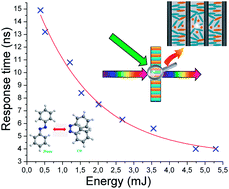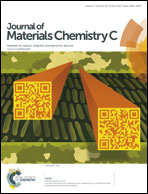Nanosecond switching of photo-responsive liquid crystal diffraction gratings
Abstract
The diffraction efficiency of periodic microstructures composed of photoresponsive liquid crystals and polymer gratings is modulated using visible CW or pulsed radiation. A polymeric template (static grating) enabled by holographic photopatterning was infiltrated by capillary flow with a high performance photosensitive (green) liquid crystal after the initial formation step. The infiltration realizes high quality diffractive structures containing well-aligned photosensitive LC molecules and layers separated by polymer walls in a transmission grating geometry. The optical anisotropy present due to the oriented liquid crystals induces a strong polarization dependence of the grating diffraction efficiency. Exposure of the periodic structure to green CW or pulsed excitation modulates both the spectral and amplitude transmission behavior of the grating structure. In particular, under the influence of single pulse excitation, the diffraction efficiency can be modulated from 87% to 17% in 4 ns with a spontaneous back relaxation time three orders of magnitude (microsecond) faster than the one observed for the same material conventionally aligned in standard glass cells. The ability to remotely and quickly change the diffraction properties of soft-composite periodic microstructures marks a breakthrough towards the realization of ultra-fast all-optical devices.


 Please wait while we load your content...
Please wait while we load your content...